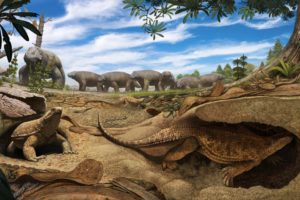
Credit: The Atlantic
Travel back in time to 260 million years ago, just before the dawn of the dinosaur era. Journey to what is now South Africa, and make your way to a river bank. Then, wait. If you’re lucky, you might see a small, hand-sized creature poking its head out of the mud. It looks like a fat lizard, with bulging flanks and stocky legs. But if you managed to grab it and flip it over, you’d find that its flanks are bulging because its ribs are exceptionally wide, broad, and flat, reinforcing its undersides. It’s almost like the little creature has half a shell.
This is Eunotosaurus, and despite its lizard-like appearance, it’s actually one of the earliest known turtles.
It was discovered in 1892 and ignored for almost a century. But by studying the many fossils of this enigmatic reptile, Tyler Lyson from the Denver Museum of Nature and Science has devised a fascinating new idea about turtle origins. He thinks that their iconic shells evolved not for defense, but for digging. […]










